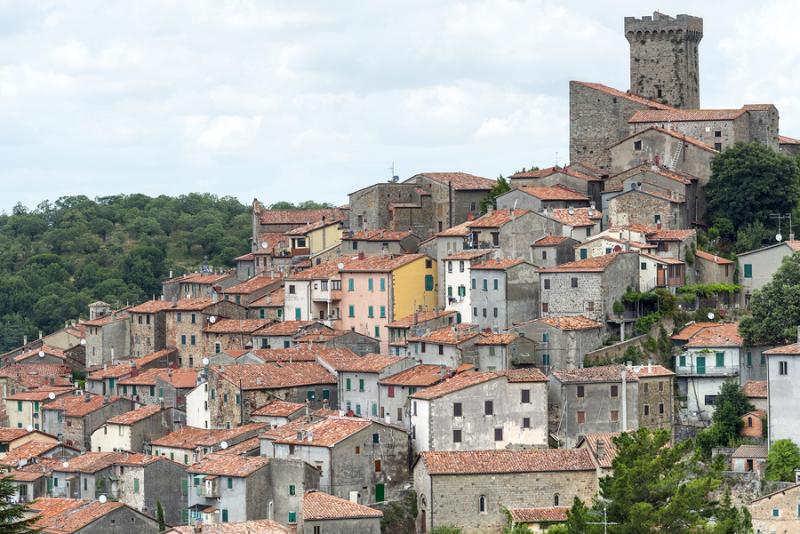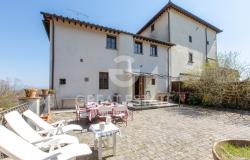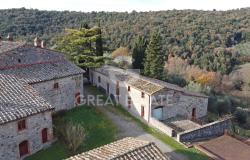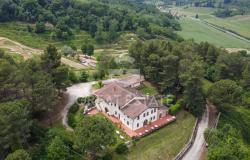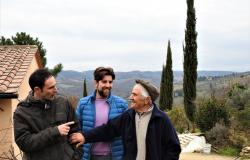It’s after midnight and the winding roads of Southern Tuscany are hard work for this sorry traveller who had a little too much red wine over dinner. All I can think about is sleep, but my husband Giulio insists we have to see the cross.
Since my skills of persuasion are severely impaired, I lose the argument not to set a course for the peak of Monte Amiata, Tuscany’s third highest mountain.
 [Monte Amiata]
[Monte Amiata]
At little over a century ago, the extremely devout locals hauled a four-ton iron cross up the mountain with the help of one very unlucky mule. Last August, those locals’ equally devout descendants installed 30,000 LED light so that the Croce del Monte Amiata could be seen for 70 kilometres.
We park our car. Around us, a handful of shuttered houses and one restaurant make a half-hearted attempt to look like a Swiss ski resort. The wind blows menacingly as we begin our ascent up the pitch-black ski slope covered in half-exposed rocks. We make it to the top, barely, and I briefly consider murdering my husband before realizing I’ll never get the car back down the mountain.
The payout is one of the most breathtaking sights in Southern Tuscany. Bathed in the almost prophetic glow of the lights, utterly alone, the surrounding countryside is operatic.
 [Croce del Monte Amiata]
[Croce del Monte Amiata]
Like so much of this part of Tuscany, Monte Amiata is overlooked and undervalued by most tourists, but the Croce della Montagna is just one example of its seemingly endless ability to astound. This magnificent cross is not meant for forestieri (the local name for foreigners). It is for the inhabitants, a guiding light in what is not always an easy existence.
The Croce del Monte Amiata is just outside Arcidosso. Once upon a time, all the mountain towns would swell with visitors escaping the summer heat. This annual migration was a chance to meet new people, make friends, fall in love, perhaps even entice a few plain dwellers to move to the mountains, but now that tradition is dead and these towns have fallen into year-round hibernation.
 [Arcidosso Tuscany]
[Arcidosso Tuscany]
Like this article, Don't miss "10 Perfect Places to Retire in Tuscany."
What is the local’s loss is the visitor’s gain. Monte Amiata is one of the few authentic destinations left in Tuscany, an escape for those wanting to experience real country life. You might have even seen it recently as the backdrop in former President Barack Obama’s Valentine’s Day tweet.

Within sight of the Cross, Ugo, the owner of Aiuole, has been serving cinghiale al cioccolato (wild boar braised in dark chocolate) for generations in his kitschy chalet restaurant.
Burrow deeper and you’ll come across Il Barilotto, where the homemade ricotta ravioli and mahogany coloured chestnut polenta are served bistro style with cubes of roast potato and rotisserie chicken. This isn’t a gimmick. It’s an honest-to-god real osteria, a throw back to Italy of the ‘70s, when eating out was cheap and the portions plentiful.
I am tempted to prattle on about the food, the artisan beer and DOP cheese, but Monte Amiata’s towns are an attraction all on their own. There is a hint of sadness in the empty shops and crumbling houses, but those same hard times have kept modernity at bay. The feeling is one of strolling through beautifully preserved ghost towns. The hideous pastel palazzos, so common in the rest of the country, are nowhere to be seen.
Aside from Arcidosso with its tales of Templar knights and self-proclaimed Messiahs, the diamond in the rough is Santa Fiora. This town by the river is the source of all of Southern Tuscany’s water and once the favoured capital of its medieval rulers. The quiet streets lead to the hidden walled garden La Peschiera, and the Chiesa della Madonna delle Nevi, a tiny church where the river runs between the pews. Once a baptismal font, it’s now covered by glass, so you can literally walk on water while you admire the faded frescoes.
 [Santa Fiora]
[Santa Fiora]
A little further up the mountain, Castel del Piano calls with its quirky modern museum and tiny coffee shop. Cafes are a rare sight in country Tuscany, but this is the headquarters of Corsini Biscotti, a pastry empire that exports handmade biscuits, cakes and panettone all over the world.
And if all this still isn’t enough to entice, then perhaps I can make the case for a detour with one final word about the locals.
The Amiatini are effusively welcoming. Tourists are a rare, but celebrated sight and a lack of English never stopped anyone. If they have to take you by the hand to get you where you need to go, they will, chattering all the while about why they love their mountain. They’ll ply you with biscuits, with stories, with legends, with nonsense. You’ll meet them at every store, every restaurant, every bar. This is their home.
They know it isn’t Florence. They know it isn’t Siena. But to them, Monte Amiata is, in its own way, immensely beautiful, and all they want is to share it with anyone who happens to come their way.
